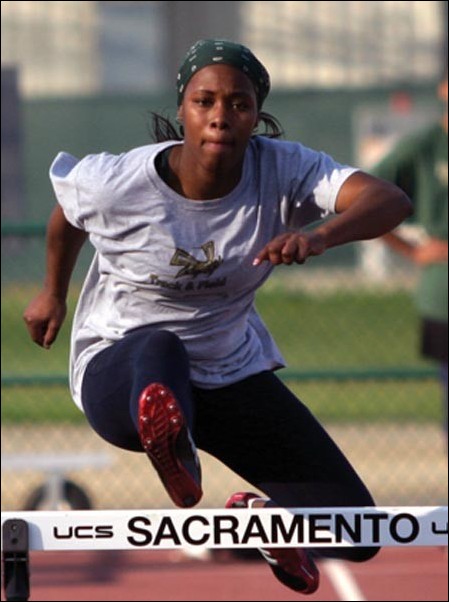Track training designed with Big Sky Championships in mind
Image: Track training designed with Big Sky Championships in mind:Junior Roshena Duree practices last week.Photo by Angel Lopez/State Hornet:
February 9, 2005
Although the Hornets just ran well in the Silver State Invite in Reno and are fatigued from the meet, there are no days off when trying to compete in Division I athletics.
Kathleen Raske, the Hornets head coach, knows her team ran hard, so she has decided to make it an easy day. For the Santana brothers, Chris, Jeff and Nick and hurdler/sprinter Chauncey Corbin, that means a 5,4,3,2,1 — running a 500, 400, 300, 200 and 100-meter sprint — followed by weight training.
It’s all part of the drill. Raske has implemented a progressive training program for the Hornets, which is focused on getting the runners to peak for the Big Sky outdoor championships.
Raske and her staff, assistants Sean Gross and Ross Richardson, as well as volunteer coach Rick Kantola, have to design routines for six main event groups — sprinters, jumpers, hurdlers, throwers, distance runners and multi-event athletes.
“It is progressive,” Raske said. “There’s a lot of science that goes into it, but the goal is for them to improve each week, and ultimately run their best at the end of the outdoor season, which is our focus here at Sac State.”
In order to keep up, many runners have to make sacrifices.
“We’re Division I athletes,” said Roshena Duree, who competes in the long jump, triple jump, and the 100-hurdles. “So basically we know that you have to eat well, you have to get enough sleep, and basically it’s an every day thing.”
No matter what the athletes do to prevent injuries and stay in shape, such rigorous training year-round does take its toll.
Senior Brandon Parker is rehabbing a bruised bone in his heel, a nagging injury that has bothered him since the Olympic Trials last July.
Kantola, who was the head coach at St. Francis High School before volunteering his time at Sac State, said there should be a happy median for off-season training.
“They should at least maintain,” he said. “You don’t have to train hard (in the summertime), but at least maintain.”
Kantola also said that one of the biggest differences between high school and college competition is strength. Often times, what an athlete does in the weight room can make all the difference when it comes time to compete.
No matter what group, the general routine is a half-hour warm-up including stretching, followed by an event specific workout in which they work on technical aspects if needed.
Then the athletes will cool down before heading to the weight room for an hour.












































































































































